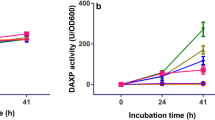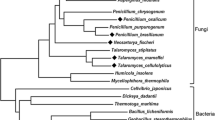Abstract
Evernia prunastri Ach., an epiphytic lichen growing on Quercus rotundifolia Lam., produces a β-1,4-glucanase (EC 3.2.1.4) and a polygalacturonase (EC 3.2.1.15). The activity of these polysaccharidases increases as a response to incubation of the lichen with carboxymethylcellulose or sodium polygalacturonate, respectively. This increase in activity is thought to be the result of enzyme induction because it is inhibited by both cycloheximide and 8-azaguanine. Both polysaccharide-degrading enzymes are partially secreted into the incubation media.
Similar content being viewed by others
References
Ascaso, C., González, C., Vicente, C. (1980) Epiphytic Evernia prunastri (L.) Ach.: ultrastructural facts. Cryptog. Bryol. Lichénol. 1, 43–51
Basham, H.G., Bateman, D.F. (1975) Relationship of cell death in plant tissue treated with a homogeneous endopectate lyase to cell wall degradation. Physiol. Plant Pathol. 5, 249–261
Bateman, D.F. (1963) The “macerating enzyme” of Rhizoctonia solani. Phytopathology 53, 1178–1186
Bateman, D.F., Basham, H.G. (1976) Degradation of plant cell walls and membranes by microbial enzymes. In: Encyclopedia of plant physiology, N. S., vol. 4: Physiological plant pathology, pp. 316–355, Heitefuss, R., Williams, P.H., eds. Springer, Berlin Heidelberg New York
Bonnier, G. (1889) Recherches sur la synthèse des lichens. Ann. Sci. Nat. Bot. Ser. 7 9, 1–32
Brodo, I.M. (1973) Substrate ecology. In: The lichens, pp. 401–441, Ahmadjian, V., Hale, M.E., eds. Academic Press, New York London
Cooper, R.M., Wood, R.K.S. (1975) Regulation of synthesis of cell wall degrading enzymes by Verticillium albo-atrum and Fusarium oxysporum f. sp. lycopersici. Physiol. Plant Pathol 5, 135–156
English, P.D., Jurale, J.B., Albersheim, P. (1971) Host-pathogen interactions. II. Parameters affecting polysaccharidedegrading enzyme secretion by Colletotrichum lindemuthianum grown in culture. Plant Physiol. 47, 1–6
Estévez, M.P., Orus, M.I., Vicente, C. (1980) Estudios morfológicos sobre Evernia prunastri de vida saprofitica. Cryptog. Bryol. Lichénol. 1, 33–41
Estévez, M.P., Orus, M.I., Vicente, C. (1982) Desfoliación de Quercus rotundifolia inducida por Evernia prunastri en condiciones naturales y simuladas. In: Estudios sobre Biologia. Libro homenaje al Profesor D. Florencio Bustinza Lachiondo, pp. 117–131, Vicente. C., Municio, A.M., coord Editorial de la Universidad Complutense, Madrid
Frank, A.B. (1877) Über die biologischen Verhältnisse des Thallus einiger Krustenflechten. Beitr. Biol. Pflanz. 2, 123–200
Hale, M.E. (1974) The biology of lichens, 2nd edn. Arnold, London
Lindau, G. (1895) Lichenologische Untersuchungen, Heft 1: Über Wachstum und Anheftungsweise der Rinderflechten. Heinrich, Dresden
Lindau, G. (1904) Die Beziehungen der Flechten zu den Pilzen. Hedwigia 43, 195–204
Lowry, O.H., Rosenbrough, N.J., Farr, A.L., Randall, R.J. (1951) Protein measurement with the folin phenol reagent. J. Biol. Chem. 193, 265–275
Urus, M.I. (1981) Alteraciones fisiológicas inducidas por Evernia prunastri (L.) Ach. al crecer epifiticamente sobre ramas de Quercus rotundifolia Lam. Tesis Doctoral, Facultad de Biología, Universidad Complutense Madrid
Orus, M.I., Ascaso, C. (1982) Localizacion de hifas liquénicas en los tejidos conductores de Quercus rotundifolia Lam. Collect. Bot. (Barcelona) 13, 325–338
Orus, M.I., Estévez, M.I., Vicente, C. (1981) Manganese depletion in chloroplasts of Quercus rotundifolia during chemical simulation of lichen epiphytic states. Physiol. Plant. 52, 263–266
Poelt, J., Hertel, H. (1968) Pachyascus lapponicus nov. gen. et spec. eine bemerkenswerte Flechtengatung unklaren Anschlusses. Ber Dtsch. Bot. Ges. 81, 210–216
Porter, L. (1917) On the attachment organs of the common corticolous Ramalinae. Proc. R. Irish Acad. Sect. B 34, 205–211
Potty, V.H. (1969) Determination of proteins in the presence of phenols and pectins. Anal. Biochem. 29, 535–539
Rondon, Y. (1968) Les lichens parasites d'autres lichens. Cah. Nat. 32, 39–41
Talmadge, K.W., Keegstra, K., Bauer, W.D., Albersheim, P. (1973) The structure of plant cell walls. I. The macromolecular components of the walls of suspension cultured sycamore cells with a detailed analysis of the pectic polysaccharides. Plant Physiol. 51, 158–173
Wessels, J.G.H., Sietsma, J.H. (1981) Fungal cell walls. A survey. In: Encyclopedia of plant physiology, N. S., vol. 13 B: Extracellular carbohydrates, pp. 352–394, Tanner, W., Loewus, F.A. eds. Springer, Berlin Heidelberg New York
Wilson, C.L. (1973) A lysosomal concept for plant pathology. Annu. Rev. Phytopathol. 11, 247–272
Zehetleiner, G. (1978) Über einige parasitische Arten der Flechtengattung Verrucaria. Nova Hedwigia Z. Kryptogamenkd. 29, 683–734
Author information
Authors and Affiliations
Rights and permissions
About this article
Cite this article
Yagüe, E., Orus, M.I. & Estevez, M.P. Extracellular polysaccharidases synthesized by the epiphytic lichen Evernia prunastri (L.) Ach.. Planta 160, 212–216 (1984). https://doi.org/10.1007/BF00402856
Received:
Accepted:
Issue Date:
DOI: https://doi.org/10.1007/BF00402856




